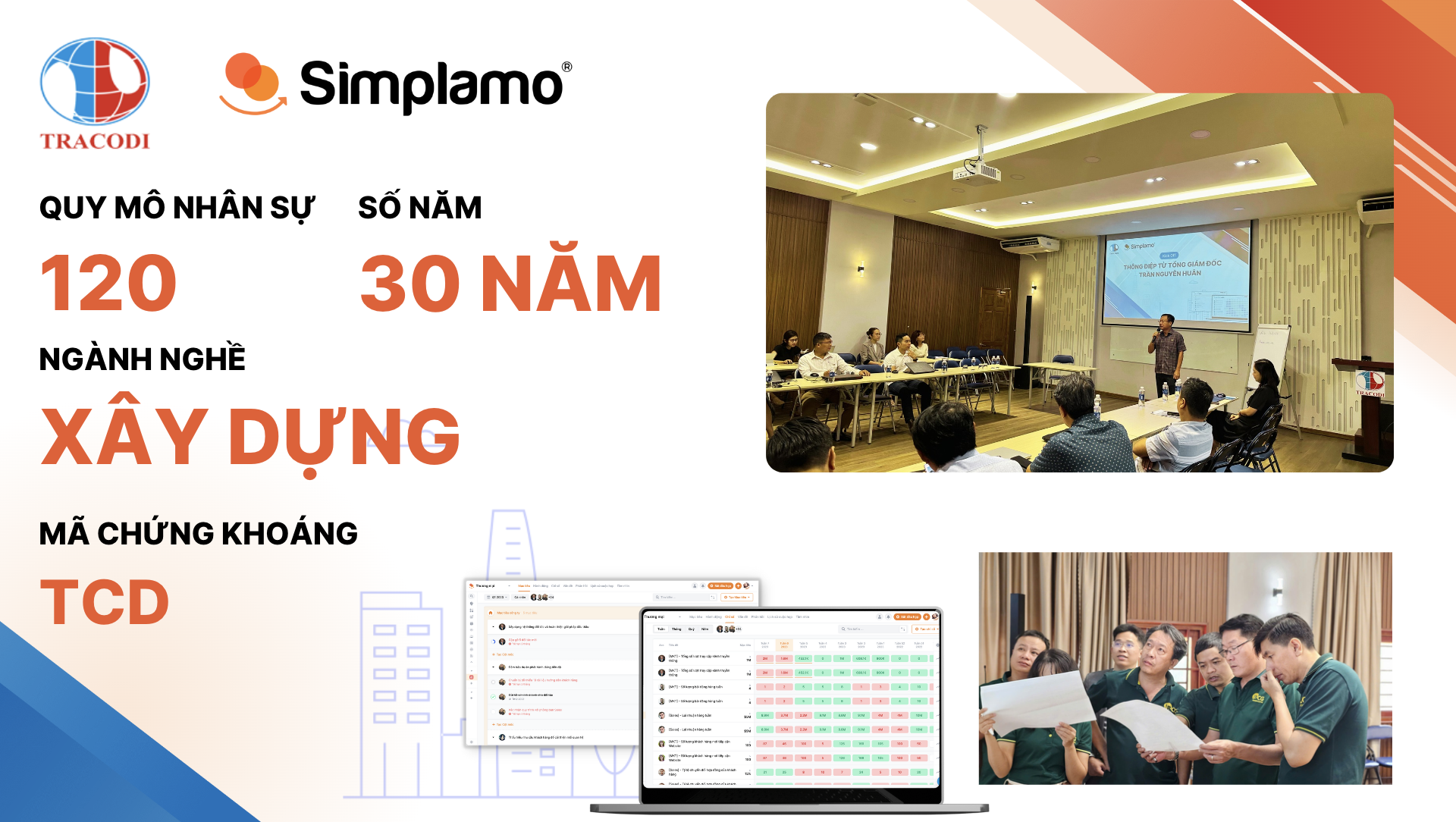
CEO TRACODI: “Simplamo là một trong những đòn bẩy công nghệ quan trọng giúp chúng ta quản trị sự ưu tiên một cách khoa học!”
Anh Trần Nguyên Huân – Tổng Giám đốc TRACODI đã chính thức tuyên bố Simplamo là trọng tâm chiến lược giúp doanh nghiệp tối ưu vận hành và quản trị sự ưu tiên theo phương pháp khoa học. Anh kêu gọi toàn bộ đội ngũ TRACODI tập trung vào chiến lược này như một đòn bẩy quan trọng trong vòng 3 năm tới để giúp doanh nghiệp vận hành đồng bộ, nâng cao năng lực thực thi và tạo ra lợi thế phát triển bền vững.
 Vậy Simplamo đã giúp TRACODI thay đổi như thế nào? Hãy cùng khám phá hành trình chuyển đổi của họ!
Vậy Simplamo đã giúp TRACODI thay đổi như thế nào? Hãy cùng khám phá hành trình chuyển đổi của họ!

I. Bài toán của một doanh nghiệp xây dựng lâu đời
Trong lĩnh vực xây dựng và phát triển hạ tầng, TRACODI là một cái tên đã khẳng định được vị thế suốt hơn 30 năm. Với bề dày kinh nghiệm, đội ngũ chuyên môn cao và hàng loạt dự án lớn, TRACODI đã không ngừng phát triển. Tuy nhiên, giống như bất kỳ doanh nghiệp lâu năm nào, TRACODI cũng đối mặt với thách thức lớn khi mở rộng quy mô.
Khi tổ chức ngày càng phát triển, các vấn đề về vận hành bắt đầu xuất hiện:
- Chồng chéo trách nhiệm khiến quy trình ra quyết định bị chậm lại.
- Sự ưu tiên công việc không rõ ràng, đội ngũ phải xử lý quá nhiều vấn đề cùng lúc.
- Thiếu đo lường hiệu suất rõ ràng, khó theo dõi tiến độ.
Câu hỏi đặt ra: Làm thế nào để TRACODI tối ưu vận hành, giúp tổ chức vận hành đồng bộ, nâng cao năng lực thực thi và tạo ra một hệ thống quản trị hiện đại?
 Câu trả lời: Simplamo – Nền tảng giúp TRACODI thiết lập một hệ thống quản trị hiện đại, rõ ràng và hiệu quả hơn.
Câu trả lời: Simplamo – Nền tảng giúp TRACODI thiết lập một hệ thống quản trị hiện đại, rõ ràng và hiệu quả hơn.
II. Hành trình Kick-off quản trị Mục tiêu & quản trị sự thay đổi cùng Simplamo
 Sau khi phân tích và đánh giá, Simplamo đã đồng hành cùng TRACODI trong một lộ trình 4 buổi làm việc chuyên sâu, tập trung vào việc xây dựng hệ thống vận hành đồng bộ, loại bỏ những điểm nghẽn và tối ưu hóa sự ưu tiên công việc.
Sau khi phân tích và đánh giá, Simplamo đã đồng hành cùng TRACODI trong một lộ trình 4 buổi làm việc chuyên sâu, tập trung vào việc xây dựng hệ thống vận hành đồng bộ, loại bỏ những điểm nghẽn và tối ưu hóa sự ưu tiên công việc.
1. Buổi 1: Cấu trúc trách nhiệm – Làm rõ khung vận hành
 Một trong những nguyên nhân khiến quá trình ra quyết định của TRACODI bị chậm lại là do chồng chéo trách nhiệm giữa các phòng ban. Không ai thực sự chịu trách nhiệm cuối cùng, và công việc bị đùn đẩy thay vì được xử lý nhanh chóng.
Một trong những nguyên nhân khiến quá trình ra quyết định của TRACODI bị chậm lại là do chồng chéo trách nhiệm giữa các phòng ban. Không ai thực sự chịu trách nhiệm cuối cùng, và công việc bị đùn đẩy thay vì được xử lý nhanh chóng.
Giải pháp: Áp dụng Accountability Chart (Sơ đồ trách nhiệm) trên Simplamo.
- Tái thiết lập cấu trúc vận hành theo đúng mô hình chuyên nghiệp.
- Mọi vị trí đều được định nghĩa rõ ràng về trách nhiệm.
- Không còn sự chồng chéo, quy trình ra quyết định nhanh hơn, minh bạch hơn.
Kết quả:
- TRACODI thiết lập được một khung vận hành gọn gàng, khoa học.
- Mỗi thành viên trong đội ngũ hiểu rõ vai trò của mình và trách nhiệm của từng bộ phận.
- Công việc không bị “tắc nghẽn” ở bất kỳ đâu, giúp tổ chức vận hành trơn tru hơn.
2. Buổi 2: Xác định Work-on vs. Work-in – Quản trị sự ưu tiên
 Một vấn đề lớn trong các doanh nghiệp lâu năm là đội ngũ quản lý bị cuốn vào công việc vận hành hằng ngày (Work-in) mà quên mất những nhiệm vụ chiến lược quan trọng giúp công ty phát triển (Work-on).
Một vấn đề lớn trong các doanh nghiệp lâu năm là đội ngũ quản lý bị cuốn vào công việc vận hành hằng ngày (Work-in) mà quên mất những nhiệm vụ chiến lược quan trọng giúp công ty phát triển (Work-on).
Giải pháp: Áp dụng phương pháp Work-on vs. Work-in.
- Work-in: Những công việc hằng ngày giúp công ty vận hành ổn định.
- Work-on: Những công việc mang tính chiến lược, giúp công ty phát triển và mở rộng.
Kết quả:
- Đội ngũ quản lý của TRACODI bắt đầu dành nhiều thời gian hơn cho các công việc chiến lược, thay vì chỉ tập trung vào giải quyết vấn đề ngắn hạn.
- Năng suất tăng lên đáng kể, khi nhân viên không còn bị mắc kẹt trong những công việc không mang lại giá trị lớn.
3. Buổi 3: Xác định các chỉ số đo lường – Định hướng hiệu quả
“Bạn không thể cải thiện những gì bạn không thể đo lường.”
Một trong những điểm yếu của TRACODI trước đây là thiếu hệ thống đo lường hiệu suất rõ ràng. Điều này dẫn đến tình trạng:
- Công việc không có tiêu chí đánh giá cụ thể.
- Khó theo dõi tiến độ và hiệu suất của từng bộ phận.
- Đội ngũ nhân sự cảm thấy thiếu động lực vì không biết được thành quả của mình có đóng góp ra sao vào sự phát triển của công ty.
 Giải pháp: Xây dựng hệ thống OKRs & KPIs trên Simplamo
Giải pháp: Xây dựng hệ thống OKRs & KPIs trên Simplamo
- OKRs (Objectives & Key Results): Xác định các mục tiêu quan trọng và cách đo lường kết quả.
- KPIs (Key Performance Indicators): Đặt ra các chỉ số hiệu suất chính giúp theo dõi và đánh giá tiến độ thực hiện mục tiêu.
Kết quả:
- Lần đầu tiên, TRACODI có một hệ thống đo lường hiệu suất rõ ràng, minh bạch.
- Nhân sự có thể tự theo dõi tiến độ công việc của mình thay vì phụ thuộc vào báo cáo hàng tháng.
- Lãnh đạo đưa ra quyết định nhanh chóng và chính xác hơn dựa trên dữ liệu thực tế.
4. Buổi 4: Cuộc họp hiệu suất – Thay thế cuộc họp truyền thống
Trước đây, các cuộc họp tại TRACODI thường kéo dài, thiếu trọng tâm và mất nhiều thời gian nhưng lại không mang lại hiệu quả cao.
Giải pháp: Chuyển từ mô hình họp truyền thống sang Cuộc họp hiệu suất trên Simplamo.
- Tập trung vào OKRs/KPIs thay vì báo cáo dài dòng.
- Giải quyết vấn đề một cách rõ ràng, ngắn gọn.
- Tạo ra sự trách nhiệm minh bạch trong toàn tổ chức.
 Kết quả:
Kết quả:
- Thời gian họp giảm đáng kể, nhưng hiệu quả tăng gấp nhiều lần.
- Các thành viên tham gia chủ động, không còn cảnh “ngồi nghe cho có”.
- Mọi vấn đề đều có người chịu trách nhiệm rõ ràng, đảm bảo mọi thứ được giải quyết triệt để.
III. TRACODI nói gì sau hành trình chuyển đổi?
Sau khi triển khai Simplamo, TRACODI đã đạt được sự thay đổi đột phá trong cách vận hành:
- Hệ thống quản trị rõ ràng, không còn chồng chéo trách nhiệm.
- Tập trung vào chiến lược dài hạn, thay vì bị cuốn vào công việc vận hành hằng ngày.
- Đo lường hiệu suất dễ dàng, giúp lãnh đạo đưa ra quyết định nhanh hơn.
- Văn hóa làm việc trở nên minh bạch, đồng bộ hơn.
- Nâng cao năng lực thực thi x2 x3, tạo lợi thế phát triển bền vững.
Chia sẻ từ đội ngũ TRACODI:
 Bạn có muốn doanh nghiệp của mình cũng đạt được những thành công như TRACODI?
Bạn có muốn doanh nghiệp của mình cũng đạt được những thành công như TRACODI?
Hãy để Simplamo đồng hành cùng bạn trong hành trình tối ưu vận hành và nâng cao năng lực thực thi ngay hôm nay!


Simplamo – Quản trị & Thực thi Mục tiêu xuất sắc, ứng dụng KPI, OKRs, BSC và 4DX. Công cụ giúp Ban điều hành, HDQT theo dõi thúc đẩy các Mục tiêu hiệu quả, nâng cao hiệu suất.
Hãy bắt đầu trải nghiệm Simplamo và cảm nhận sự thay đổi chỉ sau 4 tuần!
Đăng ký nhận buổi demo Simplamo tại: https://app.simplamo.com/vi/sign-up







Recent Comments